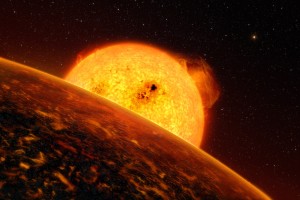Led by Prof. Brian Jackson of Boise State Physics, the Planetary Science Lab conducts research spanning our Solar System and beyond.
As part of a NASA-funded effort, Jackson’s group explores aeolian processes on Earth as an analog for Mars and Saturn’s moon Titan by using instrumented drones to probe active dust devils.
Leveraging cutting-edge data science techniques, Jackson’s group also uses data from NASA’s Kepler/K2 and TESS Missions to search for exotic planets orbiting distant stars and to probe their meteorology, work that has also enjoyed NASA support.
Measuring the Winds on Mars via Helicopter
We used attitude data from the Mars Ingenuity helicopter to estimate wind speeds and directions at altitudes between 3 and 24 m, the first time winds at such altitudes have been probed on Mars. We compared our estimates to wind data from the meteorology package MEDA on board the Mars 2020 Perseverance rover and to predictions from meteorological models. Wind directions inferred from Ingenuity data agreed with the directions measured by MEDA, when the latter were available, but deviated from model-predicted directions by as much as 180° in some cases. The inferred wind speeds are often much higher than expected. The work here provides a foundation for exploration of planetary boundary layers using drones and suggests important future avenues for research and development
Research Publications
- Profiling Near-surface Winds on Mars Using Attitude Data from Mars 2020 Ingenuity – https://iopscience.iop.org/article/10.3847/PSJ/ad8b41
Press
- “Now That’s Ingenuity: First Aircraft Measurement of Winds on Another Planet” – https://aasnova.org/2025/01/22/now-thats-ingenuity-first-aircraft-measurement-of-winds-on-another-planet/
- “Boise State professor discovers new Mars weather data” – https://www.boisestatepublicradio.org/science-research/2025-01-21/boise-state-professor-mars-weather-data
- “Jackson studies Martian winds with NASA rotorcraft data” – https://www.boisestate.edu/news/2024/12/13/jackson-studies-martian-winds-with-nasa-rotorcraft-data/
- “How windy is it on Mars? These Boise State researchers have the answer” – https://idahobusinessreview.com/2024/12/20/how-windy-is-it-on-mars-these-boise-state-researchers-have-the-answer/
Searching for Tidally Decaying Exoplanets
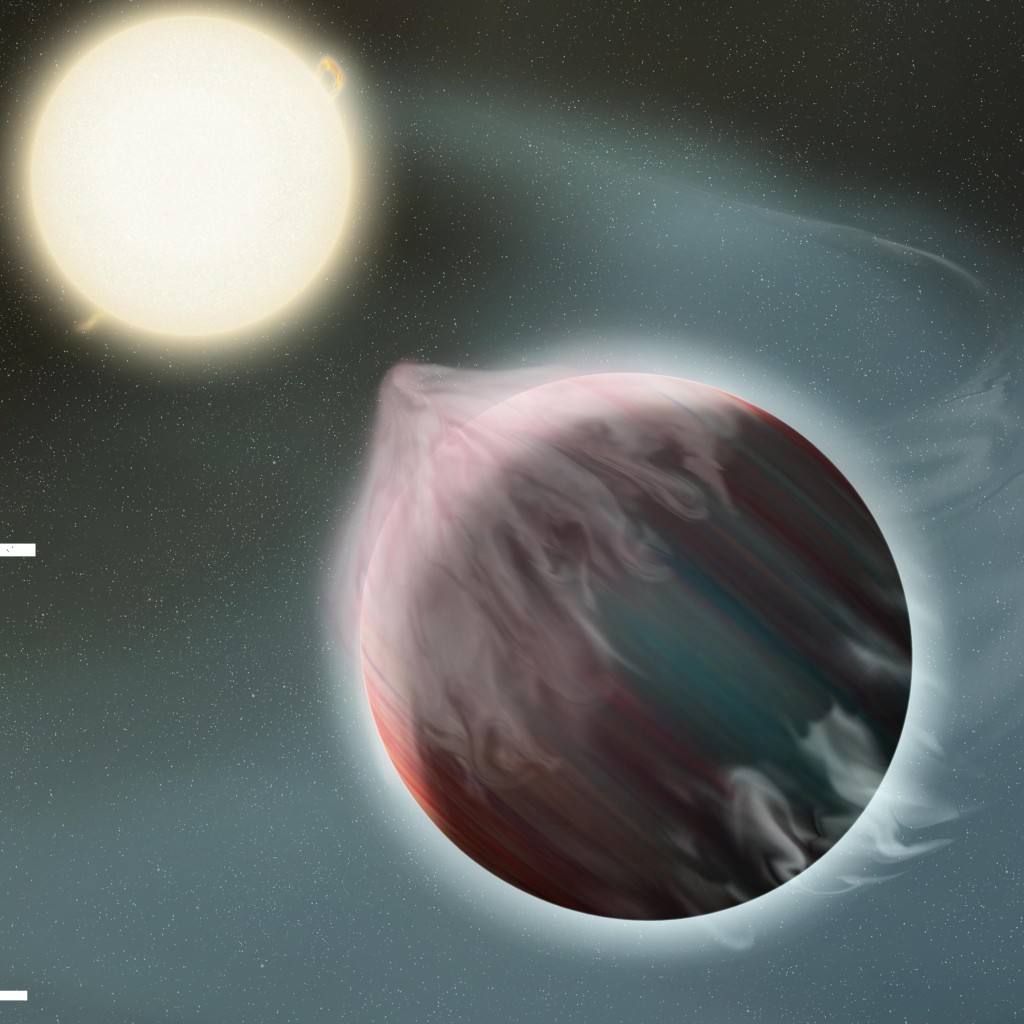
Tidal interactions between short-period exoplanets and their host stars drive orbital decay and have likely led to engulfment of planets by their stars. Precise transit timing surveys, with baselines now spanning decades for some planets, are directly detecting orbital decay for a handful of planets, with corroboration for planetary engulfment coming from independent lines of evidence. The large number of possible targets (hundreds of planets) means it is not feasible to continually observe all planets that might exhibit detectable tidal decay. For this work, we explored the properties of an exoplanet system that can maximize the likelihood for observing tidally driven transit timing variations.
Research Publications
- Jackson et al. (2023) “Metrics for Optimizing Searches for Tidally Decaying Exoplanets.” Astronomical Journal.
Martian Dust Devils and Vortices from Mars 2020 Perseverance

An important and perhaps dominant source of dust in the martian atmosphere, dust devils play a key role in Mars’ climate. Datasets from previous landed missions have revealed dust devil activity, constrained their structures, and elucidated their dust-lifting capacities. However, each landing site and observational season exhibits unique meteorological properties that shape dust devil activity and help illuminate their dependence on ambient conditions.
Data from the Mars Environmental Dynamics Analyzer (MEDA) instrument suite onboard the Mars 2020 Perseverance rover shows signals of passing vortices and dust devils. Over the mission’s first 180 sols, the rover encountered almost 1000 vortices, perhaps one quarter of which showed signs of dust-lofting. Combining our measurements of their meteorological signals with simple thermodynamic models, we estimates how tall the vortices were, and some reached as high as 2 km into the dusty martian sky.
These kinds of estimates are key for understanding how dust devils help to maintain the perpetual background of atmospheric dust on Mars, which drives martian climate and water loss to space.
Research Publications
- Jackson, B. (2022) “Estimating the Heights of Martian Vortices from Mars 2020 MEDA Data.” in review with Planetary Science Journal.
- Jackson, B. (2022) “Vortices and Dust Devils as Observed by the Mars Environmental Dynamics Analyzer Instruments on Board the Mars 2020 Perseverance Rover.” Planetary Science Journal.
Press
Martian Dust Devils and Vortices from the Insight Mission
The InSight mission has operated on the surface of Mars for nearly two Earth years, returning detections of the first marsquakes. The lander also deployed a meteorological instrument package and cameras to monitor local surface activity. These instruments have detected small-scale vortices, some of which may be dust devils. Howver, although our analysis shows that InSight encountered more than 900 vortices and collected more than 1000 images of the Martian surface, no active dust devils were imaged. Surveying the available imagery, we placed upper limits on what fraction of vortices carry dust (i.e., how many are bona fide dust devils) and estimate threshold wind speeds for dust lifting. Comparing vortex encounters and parameters with advective wind speeds, we find evidence that high wind speeds at InSight may have suppressed the formation of dust devils, explaining the lack of imaged dust devils.
Research Publications
- Jackson et al. (2020). “Inferring Vortex and Dust Devil Statistics from InSight.” Planetary Science Journal.
Dust Devils on Titan
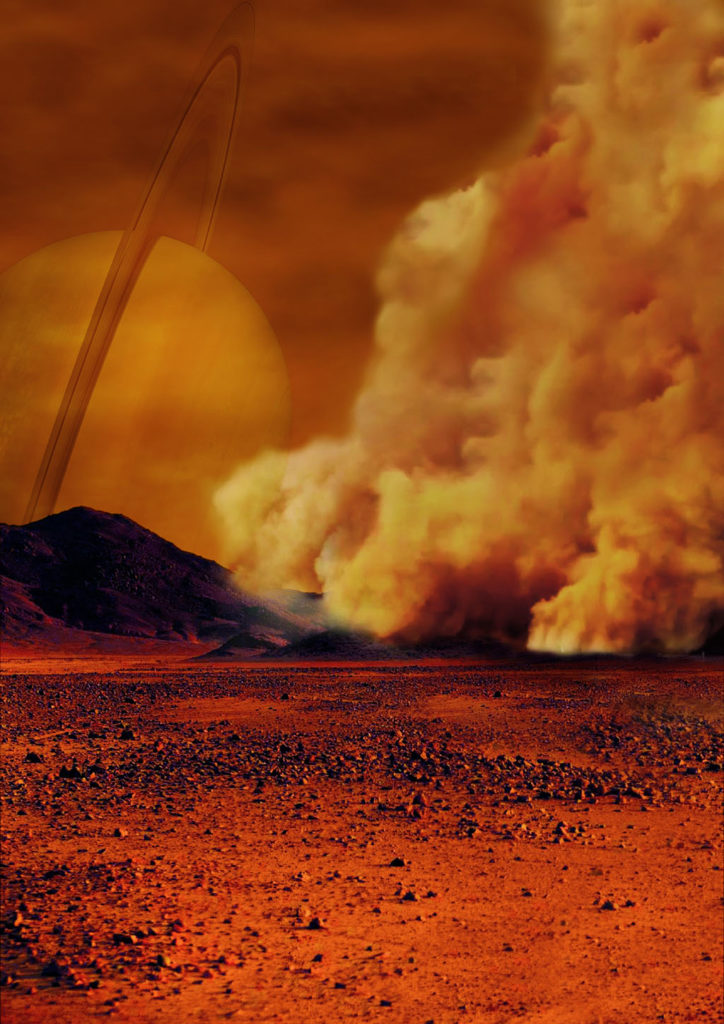
Saturn’s moon Titan may host active dust devils, small dust‐laden plumes, which could significantly contribute to transport of dust in that moon’s atmosphere. Although the exact nature of dust on Titan is unclear, previous observations confirm that there is actively blowing dust on that world. If dust devils are active on Titan’s surface, NASA’s upcoming Dragonfly mission is likely to encounter them, but dust devils on Titan are unlikely to pose a hazard to the mission.
Research Publications
- Jackson et al. (2020). “Dust Devils on Titan.” JGR: Planets.
- Jackson et al. (2020). “Dust Devils Throughout the Solar System.” Lunar and Planetary Sciences Conferences 2020.
Press Coverage - “Dust devils may roam hydrocarbon dunes on Saturn’s moon Titan.” AGU Geospace.
- “Saturn’s massive moon Titan may generate swarms of dust-fueled twisters.” Syfy Wire.
- “Titan twisters? ‘Dust devils’ may be swirling on Saturn’s largest moon.” Space.com.
- “The Best Moon in the Solar System May Be More Like Earth Than We Thought.” Popular Mechanics.
The Weather on Distant Worlds
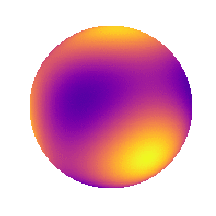
Planetary phase curves (light reflected and emitted by the planet as it orbits its star) can provide insight into atmospheric processes, and the Kepler Mission’s observational baseline spanning hundreds of days for some planets makes its dataset especially well suited to search for phase curve variability, diagnostic of meteorology as advective processes sweep thermal structures and aerosols into and out of view. This project involves analysis of archival Kepler data to understand the weather on these distant worlds.
- Jackson et al. (2018) – “Searching for Eclipse Variability for Kepler-76 b in the Kepler Dataset” – DPS Presentation
- Jackson et al. (2019) – “A Search Variability in the Atmosphere of the Hot Jupiter Kepler-76 b” – LPSC Presentation
- Jackson et al. (2019) – “Variability in the Atmosphere of the Hot Jupiter Kepler-76b” – ApJ article
Capturing Devils in the Desert
Dust devils are low-pressure, small (many to tens of meters) convective vortices powered by surface heating and rendered visible by lofted dust. Dust devils occur ubiquitously on Mars, where they may dominate the supply of atmospheric dust, and since dust contributes significantly to Mars’ atmospheric heat budget, dust devils probably play an important role in its climate. Analog studies of terrestrial devils have provided some insights into dust devil dynamics and properties but have been limited to near-surface (few meters) or relatively high altitude (hundreds of meters) sampling. Automated aerial vehicles or drones, combined with miniature, digital instrumentation, promise a novel and uniquely powerful platform from which to sample dust devils at a wide variety of altitudes. During summer 2017, our group conducted a pilot study using an instrumented quadcopter on an active field site in southeastern Oregon to probe active dust devils. The video above shows one encounter from the perspective of the drone.
- Jackson et al. (2018) “Using an Instrumented Drone to Probe Dust Devils on Oregon’s Alvord Desert.” Remote Sensing.
- Jackson et al. (2017) Presentation at Division of Planetary Sciences Conference
- Videos of dust devil encounters —
- Flight 0 – https://www.youtube.com/watch?v=goSsQD-mnYc
- Flight 1 – https://www.youtube.com/watch?v=Rj7wua4GQyc
- Flight 2 – https://www.youtube.com/watch?v=9VtcSrBjflY
A New Model of Roche-lobe Overflow for Short-Period Gaseous Planets and Binary Stars
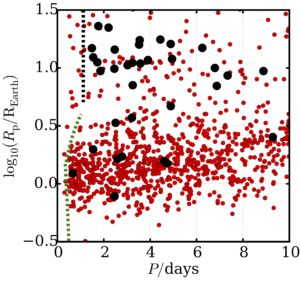
Some close-in gaseous exoplanets are nearly in Roche-lobe contact, and previous studies show tidal decay can drive hot Jupiters into contact during the main sequence of their host stars. Improving upon a previous model, we present a revised model for mass transfer in a semi-detached binary system that incorporates an extended atmosphere around the donor and allows for an arbitrary mass ratio. We apply this new formalism to hypothetical, confirmed, and candidate planetary systems to estimate mass loss rates and compare with models of evaporative mass loss. Overflow may be significant for hot Neptunes out to periods of ~2 days, while for hot Jupiters, it may only be important inward of 0.5 days. We find that CoRoT-24 b may be losing mass at a rate of more than an Earth mass in a Gyr. The hot Jupiter WASP-12 b may lose an Earth mass in a Myr, while the putative planet orbiting a T-Tauri star PTFO8-8695 might shed its atmosphere in a few Myrs. We point out that the orbital expansion that can accompany mass transfer may be less effective than previously considered because the gas accreted by the host star removes some of the system’s angular momentum from the orbit, but simple scaling arguments suggest that the Roche-lobe overflow might remain stable. Consequently, the recently discovered small planets in ultra-short-periods (< 1 day) may not be the remnants of hot Jupiters/Neptunes. The new model presented here has been incorporated into Modules for Experiments in Stellar Astrophysics (MESA).
- Jackson et al. (2016) on arxiv.org
- Github repository
Tidal Decay and Disruption of Gaseous Exoplanets
Many gaseous exoplanets in short-period orbits are on the verge or are in the process of Roche-lobe overflow (RLO). Moreover, orbital stability analysis shows tides can drive many hot Jupiters to spiral inevitably toward their host stars.
In this study, we showed that the evolution is largely determined by the core mass of the overflowing gas giant and that the orbital expansion that accompanies RLO often stops and reverses at a specific maximum period that depends on the core mass.
We suggest that RLO may often strand the remnant of a gas giant near this orbital period, and we conduct a preliminary comparison of this prediction to the observed population of small, short-period planets and find some planets in orbits that may be consistent with this picture (shown in the above figure).
To the extent that we can establish some short-period planets are indeed the remnants of gas giants, that population can elucidate the properties of gas giant cores, the properties of which remain largely unconstrained.
- Jackson et al. (2016) “Tidal Decay and Stable Roche-Lobe Overflow of Short-Period Gaseous Exoplanets.” CeMDA.
- Github repository
- Model Codes and Results
A Multi-Year Dust Devil Vortex Survey Using an Automated Search of Pressure Time-Series
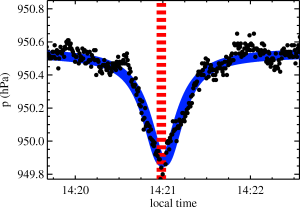
Dust devils occur in arid climates on the Earth and ubiquitously on Mars. Martian dust devils have been studied with orbiting and landed spacecraft, while most studies of terrestrial dust devils have involved manned monitoring of field sites, which can be costly both in time and personnel. As an alternative approach, my colleague Ralph Lorenz and I performed a multi-year in-situ survey of terrestrial dust devils using pressure loggers deployed at El Dorado Playa in Nevada, USA, a site known for dust devil activity.
When a dust devil passed over our pressure sensors, it appeared as a pressure dip in the time series, as illustrated in the figure. By modeling these signals, we learned a lot of about dust devils. For instance, in spite of expectations, we found signals that looked a lot like dust devils that occurred at night and even in the winter. So do dust devils happen year-round, day and night? More work will help us figure it out.
Related Press
Related Publications
- Jackson & Lorenz (2015) “A Multi-Year Dust Devil Vortex Survey Using an Automated Search of Pressure” JGR–Planets.
Looking for Very Short-Period Planets
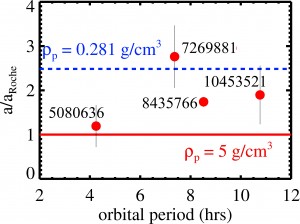
I recently led a search for very short-period transiting objects in the publicly available Kepler dataset, and this preliminary survey has revealed thirteen four planetary candidates, with periods ranging from 3.3 to 10 4 to 11 hours. I analyzed the data for these candidates using models that include transit light curves, ellipsoidal variations, and secondary eclipses, to constrain the candidates’ radii, masses, and effective temperatures. Even with masses of only a few Earth masses, the candidates’ short periods mean they may induce stellar radial velocity signals (~ 10 m/s), detectable by currently operating facilities. The origins of such short-period planets are unclear, but it’s possible that they are the remnants of disrupted hot Jupiters. If confirmed, these candidates would be some of the shortest-period planets ever discovered, and if common, such planets would be particularly amenable to discovery by the planned TESS mission, which is specifically designed to find short-period rocky planets.
Related press:
- Time Really Flies on These Kepler Planets.
- Razor’s edge — New class of exoplanets clock orbits as short as 3 hours
- Super-Fast Alien Planets May Be Skimming the Surface of Their Stars
Related scientific publications:
- Jackson+ (2013). “A Survey for Very Short-Period Planets in the Kepler Data.” arxiv 1308.1379.
- Jackson (2013). “Looking for Very Short-Period Planets with Re-Purposed Kepler.” arXiv 1309.1499.
Looking for Tides on Distant Stars
For a massive (Jupiter-sized) planet orbiting very close to its host star, the planet’s gravity can distort the shape of the star, similar to the tides raised in the Earth’s oceans by the Moon’s gravity. As these stellar tidal waves flow on the star in response to the planet’s gravity, the star can appear to brighten and dim slightly. The tides are VERY small (about 100 meters tall), and so the amount of brightening and dimming is very small, tens of parts per million, and looking for this astronomical signal is like looking for a firefly against the glare of football stadium lights. The figure below illustrates the effect.
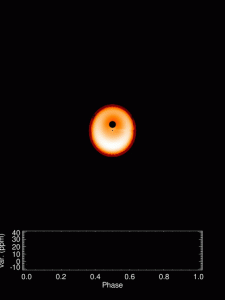
My colleagues and I created a new model for Ellipsoidal Variations Induced by a Low-Mass Companion, the EVIL-MC model, and in Jackson+ (2012), we used the EVIL-MC model to analyze observations from the Kepler mission of the HAT-P-7 system, an F-type star orbited by a roughly Jupiter-mass gas giant companion in a 2-day orbital period. Our analysis allowed us to estimate the planet’s mass and the (blackbody) temperature of the planet’s dayside, at about 2680 K. We also found a large difference between the day- and nightside planetary flux, with little nightside emission, which is qualitatively consistent with little day-to-night atmospheric circulation and in-line with other observations of very hot gas giants very close to their host stars.
Related Scientific Publications:
- Jackson+ (2012). “The EVIL-MC Model for Ellipsoidal Variations of Planet-hosting Stars and Applications to the HAT-P-7 System.” ApJ 751, 112.
- Jackson & Carlberg (2012). “Ellipsoidal Variation Analysis of Kepler Observations Using the EVIL-MC Model.” DPS Meeting.
Tidal Evolution and Mass Loss for Close-in Exoplanets
CoRoT-7 b was the first confirmed rocky exoplanet and was discovered by the CoRoT mission, but, with an orbital from its host star of only 0.0172 AU (100 times closer than the Earth is to the Sun), its origins may be unlike any rocky planet in our Solar system. In Jackson+ (2010), my colleagues and I considered the roles of tidal evolution and atmospheric mass loss in CoRoT-7 b’s history, which together have modified the planet’s mass and orbit. If CoRoT-7 b has always been a rocky body, evaporation may have driven off almost half its original mass, but the mass loss may depend sensitively on the extent of tidal decay of its orbit. As tides caused CoRoT-7 b’s orbit to decay, they brought the planet closer to its host star, thereby enhancing the mass loss rate. Such a large mass loss also suggests the possibility that CoRoT-7 b began as a gas giant planet and had its original atmosphere completely evaporated. In this case, we found that CoRoT-7 b’s original mass probably did not exceed 200 Earth masses (about two-third of a Jupiter mass). Tides raised on the host star by the planet may have significantly reduced the orbital semimajor axis, perhaps causing the planet to migrate through mean-motion resonances with the other planet in the system, CoRoT-7 c. The coupling between tidal evolution and mass loss may be important not only for CoRoT-7 b but also for other close-in exoplanets, and future studies of mass loss and orbital evolution may provide insight into the origin and fate of close-in planets, both rocky and gaseous.
Related Press:
Related Scientific Publications:
- Jackson+ (2010). “The roles of tidal evolution and evaporative mass loss in the origin of CoRoT-7 b.” MNRAS 407, 910.
- Jackson+ (2010). “Is CoRoT-7 B the Remnant Core of an Evaporated Gas Giant?” BAAS 42, 444.
Tidal Destruction of Extrasolar Planets
The distribution of the orbits of close-in exoplanets shows evidence for ongoing removal and destruction by tides. Tides raised on a planet’s host star cause the planet’s orbit to decay, even after the orbital eccentricity has dropped to zero. Comparison of the observed orbital distribution and predictions of tidal theory shows good qualitative agreement, suggesting tidal destruction of close-in exoplanets is common. The process can explain the observed cutoff in small orbital semimajor axis values, the clustering of orbital periods near three days, and the relative youth of transiting planets. Contrary to previous considerations, a mechanism to stop the inward migration of close-in planets at their current orbits is not necessarily required. Planets nearing tidal destruction may be found with extremely small semimajor axes, possibly already stripped of any gaseous envelope. The recently discovered CoroT-7 b may be an example of such a planet and will probably be destroyed by tides within the next few Gyrs. Also, where one or more planets have already been accreted, a star may exhibit an unusual composition and/or spin rate.
Related Press:
Press release from University of Washington about tidal destruction of planets- Missing Planets Attest To Destructive Power Of Stars’ Tides – Science Daily
Related Scientific Publications:
- Jackson+ (2009). “Observational Evidence for Tidal Destruction of Exoplanets.” ApJ 698, 1357.
Tidal Heating of Planets and its Effects on Their Thermal Evolution and Habitability
Extrasolar gas giant planets close to their host stars have likely undergone significant tidal evolution since the time of their formation. Tides probably dominated their orbital evolution once the dust and gas cleared away, and as the orbits evolved there was substantial tidal heating within the planets. The tidal heating history of each gas giant may have contributed significantly to the thermal budget governing the planet’s physical properties, including its radius, which in many cases may be measured by observing transit events. Typically, tidal heating increases as a planet moves inward toward its star and then decreases as its orbit circularizes. In Jackson+ (2008b), my colleagues and I computed tidal heating histories for several planets with measured radii. Several planets, including, for example, HD 209458 b, may have undergone substantial tidal heating during the past billion years, perhaps enough to explain its large measured radius. Our models also show that GJ 876 d may have experienced tremendous heating and is probably not a solid, rocky planet.
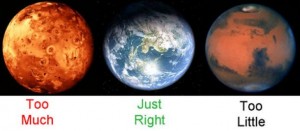
Tidal heating of rocky (or terrestrial) extrasolar planets may also span a wide range of values, depending on stellar masses and the planets’ initial orbits. Tidal heating may be sufficiently large (in many cases, in excess of radiogenic heating) and long-lived to drive plate tectonics, similar to the Earth’s, which may enhance the planet’s habitability. In other cases, excessive tidal heating may result in violent volcanism as for Jupiter’s moon Io, probably rendering them unsuitable for life. On water-rich planets, tidal heating may generate subsurface oceans analogous to the ocean in Jupiter’s moon Europa, with similar prospects for habitability. Tidal heating may enhance the outgassing of volatiles, contributing to the formation and replenishment of a planet’s atmosphere. In Jackson+ (2008c), my colleagues and I modeled the tidal heating and evolution of hypothetical extrasolar terrestrial planets to investigate the influence on planetary habitability.
Related Press:
- Tides Have Major Impact on Planet Habitability – U of AZ press release
- Talking About Tides – podcast interview with Simon Mitton about tides and planetary habitability
Related Scientific Publications:
- Jackson+ (2008c). “Tidal Heating of Extrasolar Planets.” ApJ 681, 1631.
- Jackson+ (2008b). “Tidal heating of terrestrial extrasolar planets and implications for their habitability.” MNRAS 391, 237.
- Jackson+ (2008). “Tidal Heating of Extrasolar Terrestrial-scale Planets and Constraints on Habitability.” BAAS 40, 391.
Tidal Evolution of Close-in Extrasolar Planets
The distribution of orbital eccentricities e of extrasolar planets with semimajor axes a > 0.2 AU is very uniform, and values for e are relatively large, averaging 0.3 and broadly distributed up to near 1. For a < 0.2 AU, eccentricities are much smaller (most e < 0.2), a characteristic widely attributed to damping by tides after the planets formed and the protoplanetary gas disk dissipated. Most previous estimates of the tidal damping considered the tides raised on the planets, but ignored the tides raised on the stars. Perhaps most important, in many studies the strongly coupled evolution between e and a was ignored. In Jackson+ (2008a), my colleagues and I modeled the coupled tidal evolution of e and a for many extrasolar planets and confirmed that even close-in planets probably began with broadly distributed e-values, like those for planets far from their host stars and unaffected by tides. The accompanying evolution of a-values showed most close-in planets had significantly larger a at the start of tidal migration, and the current small values of a were only reached gradually due to tides over the ages of the planets.
Related Scientific Publications:
- Jackson+ (2008a). “Tidal Evolution of Close-in Extrasolar Planets.” ApJ 678, 1396.
- Jackson+ (2008). “Tidal evolution of close-in extra-solar planets.” Proceed. IAU 249, 187.
